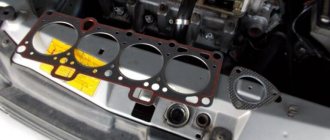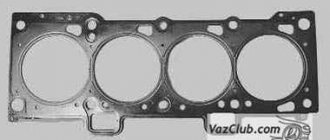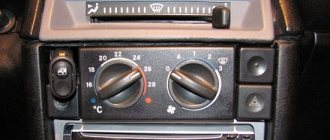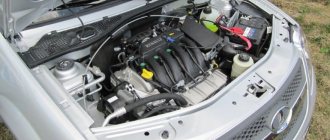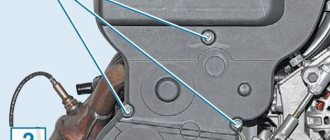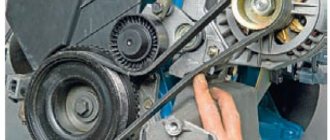For Lada Largus, it is recommended to change the engine oil every 15,000 km. or after 1 year (whichever comes first). Under severe operating conditions (large city, very dusty area), replace the oil and filter every 7-8 thousand km.
| Engine model | Engine oil volume | Factory filled oil | Recommended oils |
| K7M (8 valve) | 3.3 liters | ELF SOLARIS RNX 5W-30 | Motor oils with quality class API SL / API SM / API SN / ACEA A1/ ACEA A2/ ACEA A3/ ACEA A5 and SAE viscosity level: 15W40; 15W50 10W40; 5W30; 5W40; 5W50; 0W30; 0W40 (depending on climatic conditions). |
| K4M (16 valve) | 4.8 liters |
When do you need to change the oil in a Lada Largus engine?
According to the replacement regulations from the manufacturer, it is necessary to change the oil in the Lada Largus engine every 15 thousand kilometers . However, taking into account the specifics of driving and operating conditions, this figure can be reduced to 10 thousand km.
To determine the need to change the oil, pay attention to signs of its depletion. The main indicator is the appearance: color change, the appearance of a burnt odor, impurities and sediment, and a decrease in lubricant thickness.
To detect these signs, regular preventative oil checks are necessary. During this procedure, the lubricant level is also measured using a dipstick. A situation in which the oil remains within the permissible range when heated and cooled is considered normal.
Despite the various processes that will begin with an excess or lack of lubrication in the system, the result will be the same - increased wear of engine components. Its consequence will be expensive repairs and replacement of entire units.
In this context, another set of signs are identified that indicate problems with the lubrication system. They are associated with engine malfunctions, jerking, and extraneous sounds.
Experts do not recommend waiting for such consequences to appear. Their presence indicates not only the need to change the engine oil, but also the demand for a full diagnosis of its components by specialists.
Articles (must read!)
The plug is unscrewed from the bottom of the crankcase. It is supplied with a washer. These parts are not sold as a set, only individually.
Drain plug and washer
The article number of the plug is 7703075348. We were able to find three articles for the washer: 110265505R, 8200641648, 7703062062. In the latter case, it will just be a copper ring.
Those who screw in the plug without the washer have themselves to blame. The oil will flow out of the pan, but not immediately.
The washer can be made from a sheet of copper. The internal diameter should be 16.7 mm. If the dipstick is lost, it’s not a problem. Use article number 8200666287.
Selection of analogues
Firstly, the drain plug has alternative part numbers - 7703075210, 7703075347, 7903075033. Analogs for it:
- CORTECO 220100S
- BMW 07119919143
- METALCAUCHO 05655 or 00667
- SASIC 1630210
- NISSAN 1112800Q0A or 1112800QAA
- ASAM 80102 or 30385
- CITROEN 16393 or 2221 11
- OPEL 4433916 or 4418098
- FEBI 45890
- FA1 539.970.011 or 518.471.001
The washer with a rubber band also has analogues:
- GECKO GKFLM507
- SASIC 1640540 or 4001073
- DELLO 3011020655005R
- CITROEN 16488
- VICTORREINZ 703376900
- MANOVER MRLOGAN8853 or MRLOGAN7612
- CORTECO 006339S
- PPS 21431867
- FEBI 44793
- DT 2.10221
- AJUSA 502300
- VAICO V460562
- MERCEDES-BENZ
- SCANTECH 5321867
Filter part numbers can be found in other text.
Which oil should you choose?
The question of how to choose the right oil to replace in the engine is decided by the manufacturer’s recommendations for vehicle maintenance. For filling, the best option is the original lubricant - Elf SOLARIS RNX 5W-30. The following options are suitable alternatives:
- Shell 5W-40;
- Valvolin 5W-30;
- Gulf Formula G 5W-40;
- ZIC A+10W-40.
When choosing between mineral and synthetic oils, preference is given to the latter. Synthetics are more resistant to thermal and oxidative reactions, last longer and provide high-quality lubrication of working mechanisms.
Some car owners, however, prefer semi-synthetics for cars whose total mileage is more than 100 thousand km. This is due to the general wear and tear of parts and components, which can quickly become unusable due to synthetic lubricants.
Based on the viscosity of the oil, they are guided by seasonal temperature changes. The best options are 5W-30 and 5W-40, which are suitable for both frost and hot seasons.
Preparing for work
Preparing to change the oil in the Lada Largus engine involves purchasing parts and components. You will also need to choose a convenient place where you will work on the car.
When purchasing, pay attention to the quality of consumables. Along with the lubricating fluid, be sure to change the filter and drain plug gasket. If necessary, other components whose wear has reached or will soon reach a critical state must also be replaced.
You should buy new parts only from trusted suppliers and official dealers. When purchasing, pay attention to compliance with the article numbers, as well as the presence of a license and quality certificates.
After acquiring all the consumables, they proceed to preparing the work site. If possible, use a viewing hole, overpass or lift. It is also permissible to use a jack and supports to evenly lift the vehicle.
The need to observe safety precautions during work is especially emphasized. For better drainage, the engine is warmed up, however, given the heating and toxicity of the oil, there is a danger of thermal and chemical burns.
In this context, the use of protective clothing and rubber gloves is relevant. In the case of self-replacement, any things that you don’t mind getting dirty will do. You will also need a container to drain the used lubricant - it is not allowed to get into the soil.
Taking into account the recommendations presented, the necessary tools and equipment for changing the oil are included in the following list:
- overalls, lint-free rags or rags, gloves;
- set of socket wrenches, square 8;
- container for draining used lubricant with a volume of 5 liters;
- new oil, filter, rubber seals and gaskets, other parts as needed.
The final stage of preparation is warming up the engine. After this step, proceed directly to the oil change procedure.
How to drain engine oil
You will need : buy engine oil and an oil filter, prepare a “10” wrench, an “8” square wrench, a clean cloth, an empty 5 liter container. and a wire brush.
The engine oil should be drained after a trip while the engine is still warm (if necessary, warm it up to operating temperature). It is recommended to drive the car onto an overpass.
Procedure:
- Unscrew the oil filler plug.
- (At the bottom of the car on the engine crankcase), clean the drain plug with a wire brush, then unscrew it. Be careful not to burn yourself!
- After all the oil has run out (about 10 minutes) into a previously placed container, clean the plug from dirt and screw it back.
Under the plug there is a steel washer on the surface of which a thin layer of rubber is vulcanized. If it is damaged, replace the washer with a new one. If you do not have a new washer, you can install a copper washer with a hole diameter of 18 mm under the plug.
Do-it-yourself oil change in the Lada Largus engine
Step-by-step instructions for changing the oil in the Lada Largus engine include the following steps:
- after the engine warms up, uncork the filler neck to speed up draining;
- in the lower part, remove the engine protection, if any, and place a container to collect the lubricant;
- uncork the drain while the oil drains - clean the plug and change the gasket;
- unscrew the filter, change the cartridge and rubber seals;
- clean and wipe the seat dry, reinstall the filter element;
- after draining the oil, clean the drain hole and tighten the plug;
- New lubricant is poured into the system, the engine is warmed up for 10-15 minutes;
- check the lubricant level and tightness of connections for leaks.
The filter can be replaced before unscrewing the drain hole - the procedure in this matter is not critical. However, to save time, the process is carried out simultaneously with draining the used lubricant.
When it comes to filling volume, they focus on a value of 5 liters. The exact value is determined in accordance with the engine size and the manufacturer's recommendations. Some people focus on the amount of liquid drained.
The best option is to fill up to 70% of the required volume and then top up with measurements of the current level. This option allows you to avoid excess or lack of oil, but you also need to take into account possible changes after the first warm-up of the engine.
The cooling system elements are checked for preventive purposes. The procedure is optional, and taking into account the frequency of replacing antifreeze, it seems to many to be completely unnecessary. However, it allows you to detect and eliminate faults in a timely manner, ensuring high-quality and reliable engine operation.
During preventive maintenance, attention is paid to the main connections of the cooling system, checked for tightness, leaks and serviceability of fasteners. The condition of the antifreeze itself is also assessed; a significant change in color and the appearance of sediment indicates the need for replacement.
Features of changing oil in 8-valve and 16-valve engines
Changing the oil in a Largus 16 valve engine is carried out according to the same scheme as in cars with 8 valves. This is due not only to the relatedness of the assemblies, but also to the standardization of the overall process.
Engine features do not affect the choice of oil; certain differences will only be in the volume of lubricant poured. 16 valves require about 5 liters, while changing the oil in a Largus 8 valve engine requires 4 liters.
There are also nuances with the location of the filter. It is easy to recognize by its cylindrical blue casing, but access to it may be limited.
In both cases, unscrewing is done by hand. If it doesn’t work, use a special tool. However, when tightening, you should not use the same tools - tighten the casing by hand, otherwise it may burst.
Installing a new filter
First of all, it is necessary to remove the protection on the engine (for K4M, 16 valves). To do this, you need to unscrew six screws with a “10” key. The filter part is removed counterclockwise. The container for drainage should be ready. If you don't have a special tool to remove the filter, you can use a screwdriver as a lever.
Removing a filter
Now fill the new filter about 1/3 full with grease, lubricate the O-ring and install it in place.
New oil filter
Pouring new motor substance into a Lada car
Pour the prepared lubricant through the oil filler neck. The quantity depends on the engine type (16- or 8-valve). The dipstick will indicate the level of the filled substance. The mark should be halfway between the maximum and minimum values.
Dipstick
Now you need to warm up the engine at idle speed. Approximately 3 minutes after starting the engine, the emergency light will go off. If oil leaks are not found anywhere, then everything has been done correctly. After turning off the engine, check the level of the filled consumables again. If necessary, top up to the appropriate rate. The norm for 16 and 8 Lada engine models is determined the same way.
Oil change intervals
The frequency of oil changes in the Lada Largus engine is 15 thousand km. However, when making calculations, individual factors that influence the production of lubricating fluid should be taken into account:
- duration of trips around the city, frequency of stops and turns;
- aggressive driving style, high speeds;
- environment, annual and daily temperature changes;
- dustiness of roads, their surface, slipping.
All this can reduce the service life of the lubricant to 10 thousand km. In this context, regular oil checking becomes recommended. Its implementation will allow us to determine the frequency of lubricant replacement at an individual level.
The consequences of untimely oil changes are related to its functionality. In addition to lubricating mechanisms, this liquid provides heat and work product removal. Increased engine overheating will be the first consequence of its expired service life.
When heated, the working parts will begin to wear out faster, which will increase sediment and impurities in the circulating fluid. This will lead to clogging of the filter and reduce its throughput, which will cause oil starvation in the main engine components.
Further consequences depend on the total mileage of the vehicle and the service life of its components. The older the parts, the faster they will begin to fail and the larger the subsequent repairs will be.

